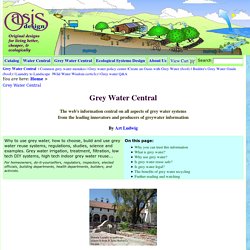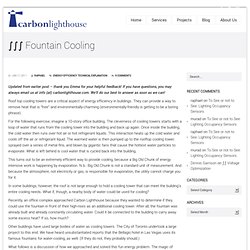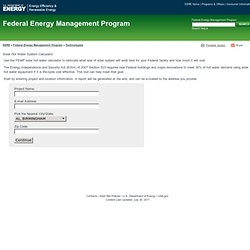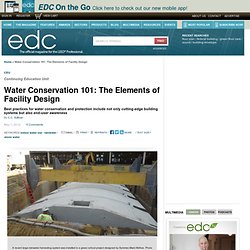

50118. Grey Water Information Central. What is grey water?

Any washwater that has been used in the home, except water from toilets, is called grey water. Dish, shower, sink, and laundry water comprise 50-80% of residential "waste" water. This may be reused for other purposes, especially landscape irrigation. (This is the definition common in Europe and Australia. Some jurisdictions in the US exclude kitchen sink water and diaper wash water from their definition of grey water. Why use grey water? It's a waste to irrigate with great quantities of drinking water when plants thrive on used water containing small bits of compost. Lower fresh water use Less strain on failing septic tank or treatment plant Better treatment (topsoil is many times more effective than subsoil or treatment plant) Less energy and chemical use Groundwater recharge Plant growth Reclamation of otherwise wasted nutrients Increased awareness of and sensitivity to natural cycles Healthy fruit from sanitary irrigation of edible landscape.
Application Sizing - Food Service / Restaurant. Www.fishnick.com/design/waterheating/Water_Heating_Design_Guide_Final_FNi_disclaimer.pdf. Www.hotwater.com/lit/sizing/aossg88210.pdf. Www.epa.gov/watersense/commercial/docs/factsheets/restaurants_fact_sheet_508.pdf. Wp-content/uploads/2011/04/Water-Usage-Chart.pdf. Untitled. Figure 1 Annual water consumption in hotels. Carbon Lighthouse. Updated from earlier post – thank you Emma for your helpful feedback!

If you have questions, you may always email us at info {at} carbonlighthouse.com. We’ll do our best to answer as soon as we can! Roof top cooling towers are a critical aspect of energy efficiency in buildings. They can provide a way to remove heat that is “free” and environmentally-charming (environmentally-friendly is getting to be a boring phrase). For the following exercise, imagine a 10-story office building. This turns out to be an extremely efficient way to provide cooling, because a Big Old Chunk of energy intensive work is happening by evaporation.
In some buildings, however, the roof is not large enough to hold a cooling tower that can meet the building’s entire cooling needs. Recently, an office complex approached Carbon Lighthouse because they wanted to determine if they could use the fountain in front of their high-rises as an additional cooling tower.
Okay, onto the good stuff. Q = U · A · (T2 – T1) where: Water Usage Calculator. Solar Hot Water System Calculator. Skip to Content EERE Home | Programs & Offices | Consumer Information Search Help Federal Energy Management Program EERE » Federal Energy Management Program » Technologies Solar Hot Water System Calculator Use the FEMP solar hot water calculator to estimate what size of solar system will work best for your Federal facility and how much it will cost.

The Energy Independence and Security Act (EISA) of 2007 Section 523 requires new Federal buildings and major renovations to meet 30% of hot water demand using solar hot water equipment if it is life-cycle cost effective. Start by entering project and location information. Untitled. Cooling_tower_calculator << United Labs, Inc. MaP-Toilet-Test-Results-9th-Edition.pdf (application/pdf Object) Water Conservation 101: The Elements of Facility Design. Take the quiz here.

Reading this article provides professional education in green building, including Sustainable Design (SD) and Health, Safety and Welfare (HSW) credits. Upon finishing, the reader should be able to: Describe general approaches to building water conservation and related topics in LEED certification programs. List building technologies designed to improve water conservation or water capture and reuse in nonresidential facilities. Discuss site and outdoor approaches for water efficiency. EDC is a registered provider with The American Institute of Architects Continuing Education Systems. EDC is also a USGBC Education Provider; this course is approved by USGBC for 1 GBCI CE Hour toward LEED Professional credentialing maintenance. The urgency of green building design is felt most powerfully with water-consuming systems.
Second, costs are creeping upward. For sensible project planning, experts start by identifying the unique needs of each situation.